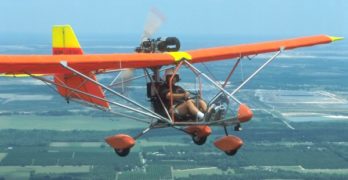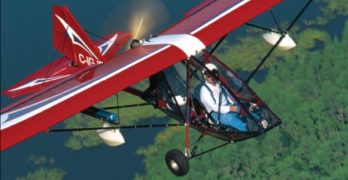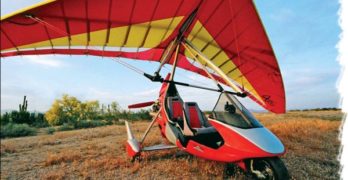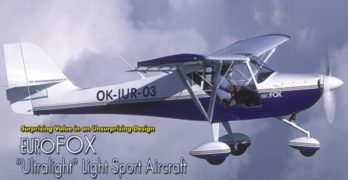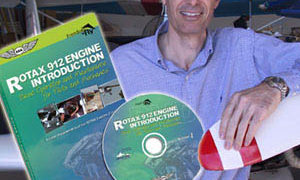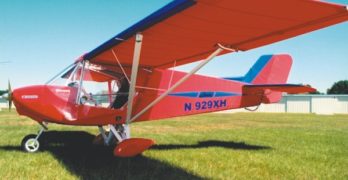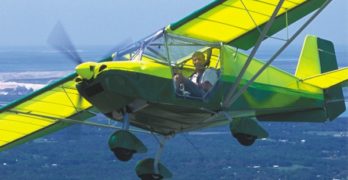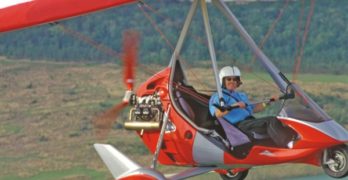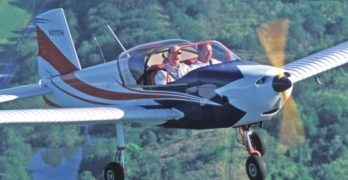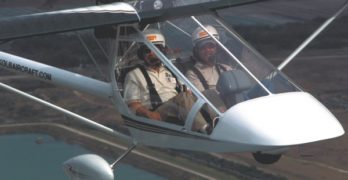[UPDATE fall 2009 — Aero-Works left the business several years ago (though in late 2009, originator Terry Raber said he will return to production). Meanwhile, producer Wings of Freedom has begun work on the Phoenix-103, a derivation of the Aero-Lite 103 but with numerous small changes.
This article refers to the aircraft built by AeroWorks and will not be identical to the Aero-Lite 103. The companies are different and Terry Raber has no association with Wings of Freedom.
In the uncertain “new world of Sport Pilot,”
one thing remains exactly as it was – FAR Part 103. While new rules and regulations may shake the ground under the feet of ultralight pilots, Aero-Works continues to produce their popular AeroLite 103. If you build it carefully, you can still enjoy a twin-cylinder ultralight with lots of features that fits Part 103.
Even airline pilots who normally fly under smothering regulations appreciate FAA’s simplest, least intrusive rule, Part 103.
Search Results for : Four stroke and ultralight
Not finding exactly what you expected? Try our advanced search option.
Select a manufacturer to go straight to all our content about that manufacturer.
Select an aircraft model to go straight to all our content about that model.
Lightplane Offerings From Canada
The Beaver and Chinook ultralight-like aircraft are arguably two of the bestknown
lightweight designs coming from Canada. Aircraft Sales and Parts, more
commonly known as ASAP, is the company that rescued and now manufactures
and sells these designs, along with a powered parachute from its sister company,
Summit Powered Parachutes. The tale of ASAP’s involvement with the Chinook
and Beaver offers insight into ultralight progress – Canadian style.
A History Lesson
Perhaps the most famous ultralight
to come out of Canada is the Beaver.
With a reported 2,200 flying units
since the early 1980s, it’s a successful
design. However, due to corporate
missteps by the companies that
owned the brand, the Beaver series
was nearly lost. Originally, the Beaver
models were manufactured by
Spectrum Aircraft Inc. Reorganization
left the ultralight in the hands
of a company called Beaver RX Enterprises.
In 1993, that company closed
its doors and stranded thousands of
Beaver aircraft owners, along with
all the dealerships that sold and serviced
them.
A Sport Bike of the Air
First weight-shift S-LSA sets the bar high
In street vernacular, the term
“crotch rocket” refers to a lean,
lightweight, high-performance
motorcycle. Sometimes called sport
bikes, these machines have become
radically snazzy in modern years by
the addition of rakish body panels.
Sport bikes accelerate like a rocket.
They corner tightly, and they turn
heads wherever they go.
The first weight-shift trike to earn
special light-sport aircraft (S-LSA) approval,
the Air Creation Tanarg might
be compared to just such a vehicle. In
fact, that’s precisely how its French
manufacturer describes its newest
machine.
Yet, while sport bikes are touchy
and have less margin for error than
other motorcycles, Air Creation’s flying
sport bike is highly stable with predictable
handling. Compare Tanarg’s
performance to other trikes, and it
comes out as a top-of-the-line entry.
The name Tanarg comes from the
highest mountain range in the Ardeche
region of southern France, not
far from the Air Creation factory.
Surprising Value in an Unsurprising Design
On September 1, 2004, when the Federal Aviation Administration (FAA) released the long-anticipated Sport Pilot and Light-Sport Aircraft regulations, a new aviation segment called light sport aircraft (LSA) was created. Some saw LSA as a bridge between ultralights and general aviation aircraft, but are LSA so different from ultralights? The answer is a mixed yes and no.
Yes, many aircraft look different in that the extra weight they may possess allows them to have full composite fuselages, a panel full of instruments even including fancy glass cockpit hardware, plus they can be delivered ready to fly even as 2-seaters. That’s different than our ultralight trainers or our amateur-built recreational aircraft that resemble those trainers. Prices for these light sport aircraft have pushed them beyond the budgets of many pilots.
On the other hand, these aircraft needn’t be all that different from ultralights. The new rule doesn’t require that they weigh the maximum 1,320 pounds.
Lockwood to Help Educate A&Ps on Rotax Powerplants
A&P acceptance (or lack thereof) is a leading reason for Cessna’s decision to use the Continental O-200D in Skycatcher. Surveys through their Cessna Pilot Centers showed that a majority of FAA-licensed mechanics preferred an engine they already know. Most lack knowledge of the Rotax 9-series that powers the majority of the LSA fleet. And when an expert knows little about a new product, human nature compels him to resist. *** Trying to educate A&Ps on the best-selling LSA engine is one task of Rotax service center operator, Phil Lockwood. This winter, he’ll be giving hourlong presentations for A&Ps (and owners), trying to encourage to A&Ps to take a pair of two-day courses to bring them up to speed with the Austrian engines. *** Of 62 presently approved SLSA models, only 8 (13%) use another engine (Continental or Jabiru). Starting in 1973 with the ultralight market, Rotax has produced more than 125,000 aircraft engines.
New Look for Xair Import; Xair H
UPDATE 2008: The following article preceded the arrival of the X-Air LS offered by X-Air LSA, certified in 2008 as a Special Light-Sport Aircraft under ASTM standards. The article below appears unchanged from the original, but the airframe is essentially identical. So, while panel changes were made along with a few minor updates, flying qualities reported in the following article should largely match that of the new LSA version.
It was Tax Day, April 15, and I prepared to fly an Xair H (N#929XH) owned by importer Bill Magrini of Light Wing Aircraft. It seemed an appropriate day to forget about what I owed the Internal Revenue Service and to enjoy some ultralight flying. Fortunately, the Xair H didn’t disappoint.
The Xair H isn’t the designer or fabricator’s name for the new plane. When I first saw the then-prototype design at a French airshow in ’02, the new model was named Hanuman, which means little to American pilots.
Sky Ranger Defines a New Niche
Listening to the aviation media drumbeat about Sport Pilot/Light-Sport Aircraft, you could be excused for thinking ultralights had “vanished” and that it now takes $55,000 to $95,000 to buy a light recreational aircraft. Fortunately, this just isn’t so.
We’re beginning to identify the emergence of a middle ground and the Sky Ranger is positioned in this space. According to my Sky Ranger check pilot Ryan Gross, our test plane could be supplied by Sky Ranger Aircraft Company for $40,000 in ready-to-fly form. While this is significantly more than the Sky Ranger 503 kit I flew four years ago, it is about half the cost of the average new 3-axis light-sport aircraft (LSA), though some models, like the Fantasy Air Allegro 2000, are only $15,000 more than the Sky Ranger.
Regardless of how the Sky Ranger Aircraft Company may elect to supply fully-built aircraft versus kits, the design of this airplane was optimized to be a quick and easily-built kit.
The Tanarg: Most Deluxe Trike Ever?
When Air Création introduced their beautiful Tanarg trike to American pilots in 2005, it earned a very warm response and, at the same time, shock at its $53,000 price tag – some $10,000 more than the next closest high-end trike.
Pronounced Tan-ARG (rhyme it with “barge,” except the G is said softly, more like TAN-arz), the machine is impressive. Even for those pilots or newcomers who regard weight-shift control trikes as “weird,” or “hard to understand,” the Tanarg design concept earns respect rapidly. This aircraft has received enormous attention to detail while also gaining in strength and ease of use. Air Création engineers built on many successful years of designing and producing lots of trikes – some 2,500 of them – to create a stunning work of aeronautical art. Nothing on the market is quite like the Tanarg.
The last time I wrote about Air Création, I talked about my experience with their wonderful new iXess wing (once again introducing a hard-to-pronounce name).
IndUS Sky Skooter…Proven Trainer with ePod
he proven airframe and modern panel of the Sky Skooter make perhaps the oddest, yet most appropriate of mates. Each from a different age – the T-211’s unique ribbed wing beckons from the 1940s while the ePod streaks ahead in the 2000s – they nonetheless complement each other.
The Sky Skooter is the fun little variant of the T-211 series, including the FAA-certified T-211 and the ASTM standards-compliant (LSA certified) Thorpedo. The company can deliver just about any version of John Thorp’s groundbreaking design, the very one that lead to Piper’s Cherokee, which sold tens of thousands.
Complementing the joyful and innocent Sky Skooter with the most pleasant in-flight handling comes the visitor from the future: IndUS Aviation’s ePod. Putting these together for a flight review shows the past and the future of light-sport aviation.
Long Perspective
The T-211 has a long, rich aviation history. The model dates back to designs studies in the early 1940s that lead to the Lockheed Little Dipper, a single-place light aircraft created by legendary designer John Thorp.
Refined Kolb Mark III Xtra
“Xtra” - a word to make a computer spell-checker stumble – is an appropriate name for this month’s pilot’s report, The New Kolb Aircraft Company Mark III Xtra side-by-side 2-seater. It literally offers extra in several ways pilots will like.
The venerable Mark III has been through a series of changes since original company founder Homer Kolb first brought out a 2-seater called the TwinStar. The latest change does a lot to alter the appearance of the older design.
Kolb designs have narrow noses like a lot of other designs. The new Xtra presents a clean edge cutting through the air, but it now has a wider look – at least from head-on – that imparts a new feel to the occupants. Some will say the “Xtra” comes from “Extra-Wide.” With its bulging doors, the new cabin is 45 inches wide (42.5 at the hips).
Although the design will look bigger and heavier to some, the new shape is one you’ll come to like… if you have a seat.
- « Previous Page
- 1
- …
- 8
- 9
- 10
- 11
- 12
- …
- 17
- Next Page »


